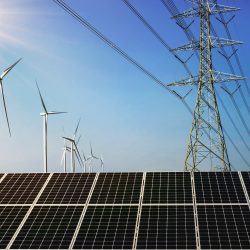BY KARISSA GARCIA (World Business Academy Intern, Summer 2020)
Since the World Business Academy’s founding, the organization has had a particular drive to discover and help implement solutions in the energy sector. Over the last several years, we have shifted this focus heavily on microgrids. Years ago we collaborated with local organizations to launch the Montecito Community Microgrid Initiative. At the time, we wrote, “Although linked to the main electric grid, during a power outage a Community Microgrid can isolate from the broader grid and provide indefinite renewables-driven backup power to critical facilities. This scalable and replicable approach saves money, provides local economic stimulation, and provisions secure and stable clean local energy, even during disasters of any duration. Community Microgrids deliver an unparalleled trifecta of economic, environmental, and resilience benefits across communities.” That remains true today. We also focused on what we call SBR3, a plan to create a more reliable, resilient, and renewable future in the local area. To this day, we’re working on furthering these solutions as you will read below.
In a recent episode of Solutions News, Rinaldo Brutoco sat down with Lorenzo Kristov, Ph.D, an independent policy expert who has experience in advising at both state and national levels. As a consultant for electric systems, policy structure, and market design, his focus on transitioning power systems that integrate high levels of renewable generation and distributed energy resources (DER) is crucial to consider after a summer of unprecedented climate change related threats on energy supplies. On the show, Kristov and Brutoco discussed the necessity for transitioning to community energy systems considering that energy is needed for everything we do while being a primary cause of climate and ecosystem disruption.
As residents of California feel record-breaking effects of wildfires and rolling blackouts across the state from abnormal heat waves, independent electrical systems are unable to supply power for the first time in about 20 years and forced power outages for thousands of customers during some of the hottest days on record. However, California microgrids showed their heroic resourcefulness when multiple microgrids provided power to their owners and community members. Microgrids are essential to transition to clean, renewable, and reliable energy to combat climate change related impacts such as energy blackouts. The flexible resource is a self-contained energy system that can connect and contribute to local resources, and disconnect from the power grid when needed to absorb the shock serving as a backup grid.
Kristov explains that the process of implementing microgrids as community energy systems aims to maintain the three “urgent missions” of sustainability, resilience, and equity. Achieving all three goals requires local action, as they have not all been recognized at state or federal policy levels. In California, policies and targets implemented for decarbonization and clean energy are making progressive strides to energy independence, such as SB-100 passed in 2018 to power the state with carbon-free electricity by 2045. Nonetheless, we still need more state level policy commitments to energy resilient communities and programs to empower local governments to plan and implement local energy systems. “Realizing this vision of more decentralized energy, more resilient energy, and local benefits,” says Kristov, “really requires changes at the legislative level and in the regulatory framework.”
In order to achieve such policies, it is essential to continue to act at the local level to move in the direction of energy independence. Following the Academy’s motto to “think globally, act locally,” our job in California is to show the transition is possible and can be done at no additional cost to ratepayers so federal and other international policies can be put in place. We must elect leaders who support a green economy, educate those around us, and promote energy independence. “The answer is simple,” says Solutions News host Rinaldo Brutoco. “We have the technology. We have the know-how. We have the resources. All we lack is the political will.” Supporting this suggestion, Kristov argues that local governments need to create a state level structure that advances state and policy goals, meets local needs and priorities, and supports the macro power grid. States must also reform the distribution utilities of local energy giants with a large political and economic power base. As a result, demand needs to come from the bottom up just as much as policy needs to be implemented from the top down.
We must also collectively change our mindset and be the ones to take the initiative to move forward and choose to “cut the wires” to do the seemingly impossible, similar to when the world transitioned from wired to cellular phones. To put the example in perspective, the wired phone system only gave about 23 percent of the world’s population access to phones at its peak in 1970. Well over 96 percent of the world population has access to wireless phones today due to cutting wires and taking the chance on mobile phones. Furthermore, Kristov proposes that “consumers now become participants in the grids” by committing to reducing and managing peaks of energy usage and contributing to the development of infrastructure. Implementing renewable energy through microgrids and other forms of community energy systems is possible when we utilize our ambition and commit to our future.
For more on DER from World Business Academy see the following:
- Lorenzo Kristov on Solutions News
- Perspectives: Wind, Wires, and Fire
- California Moonshot
- The Hydrogen Energy Paradigm
- Microgrids: Our Energy Future
- Montecito Community Microgrid Initiative
Other Related Resources:

